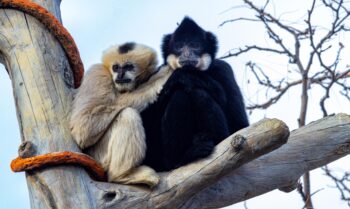June 14, 2019
A Tale of Two Kitties
How Denver Zoo is leading the way on socializing male fishing cats
By Molly Kainuma
Animal introductions happen whenever a new animal is joining a group, just like when our new African lion Tobias met the rest of our female pride. Introductions like that follow best practices, but there are some unique cases that we approach a little differently here at Denver Zoo.
At Fishing Cat-pacity
In February 2017, we welcomed our first fishing kitten ever born at Denver Zoo, a male named Miso-Chi. With only about 50 fishing cats in zoos around the United States, the Association of Zoos and Aquarium's Fishing Cat Species Survival Plan (SSP) wants to see more breeding within the zoo population. According to the IUCN, fishing cats are endangered, and it’s our goal to maintain a healthy, genetically diverse population in AZA zoos. As our kitten Miso-Chi reached maturity, our animal care team needed to make some decisions on how to house our three adult fishing cats. Per the SSP’s recommendations, we sent Miso-Chi’s mom Namfon to another institution for breeding. This left us with Miso-Chi and his father Ronaldo. But it also left us with a big opportunity – to be one of the only AZA zoos in North America to socialize our two male fishing cats.
Feline Social
Fishing cats are thought to be solitary, but there is still much to be learned about their activities, behavior, and social interactions even in the wild. So, housing two solitary males required us to rotate which cat was in the public-facing side of the habitat. After spending a lot of time observing Miso-Chi and Ronaldo, we’d never seen any aggression or negative behaviors between the two males. This got us thinking, could we successfully house two male fishing cats together? Benefits of housing them together would include more space, increased opportunity for social interactions, and the chance for guests to observe this socialization. It would also provide valuable information for other zoos that may be in a similar situation. While there is always some risk involved in animal introductions, we felt the benefits were worthy of the endeavor.
Father/Son Bonding Time
The introduction plan looked a little different than the one we had for our lions. The fishing cats had already been in a “howdy” situation for almost two years, able to see and smell each other behind the scenes. For these two, we focused on how to strategically set up the habitat to allow enough space and escape routes to avoid altercations. We anticipated some low-level spats (as cats do) and were prepared to separate or intervene if things were not going well. Luckily, our instincts were correct and since we opened the door between them in early January, we’ve seen almost no concerning behavior and even catch them sitting next to each other throughout the day. We see Miso-Chi respect his dad, and Ronaldo appropriately asserting dominance when he feels the need. They’ve been spending every day together for the past 6 months, only separated for feedings and overnight. Next time you come to Village Hall inside Toyota Elephant Passage, you can see them together, exploring their habitat, and investigating their pool and stream throughout the day.
Subscribe
Be among the first to hear the latest animal updates, important stories and details about all the fun happening around Denver Zoo.
Tags
-
 April 15, 2024
April 15, 2024Good Luck, Chuck!
Good Luck, Chuck! Beloved Bachelor Relocating as Part of Asian Elephant Species Survival Plan In a heartfelt and collaborative…
-
 April 15, 2024
April 15, 2024African Impact
African Impact Two New African Field Conservation ProgramsAim to Protect Gorillas + Grey Crowned Cranes We're honored to provide…
-
 March 1, 2024
March 1, 2024Last Place(s) on Earth
Last Place(s) on Earth New Asian Field Conservation Programs Protect Asian Elephants, Sumatran Orangutans + more Indonesia's Leuser Ecosystem…

